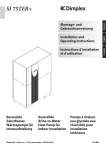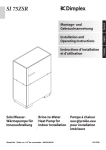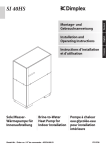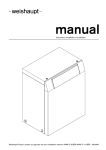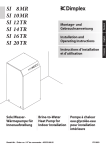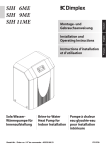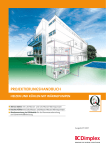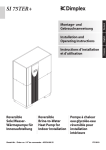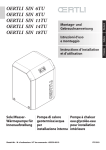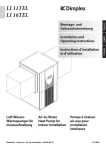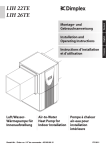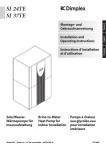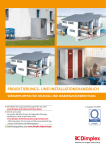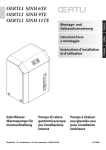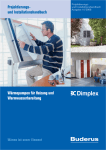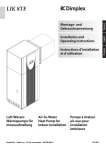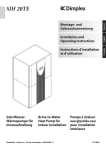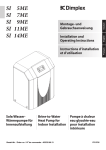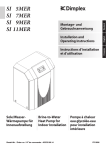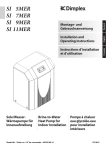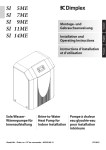Download Installation Instructions and Operating Instructions SI
Transcript
Reversible Sole/WasserWärmepumpe für Innenaufstellung Installation and Operating Instructions English Instructions d’installation et d’utilisation Français Montage- und Gebrauchsanweisung Reversible Brine-to-Water Heat Pump for Indoor Installation Bestell-Nr. / Order no. / No de commande : 452234.66.23 Deutsch SI 30TER+ Pompe à chaleur eau glycolée-eau réversible pour installation intérieure FD 8804 Table of contents Please Read Immediately .............................................................................................................E-2 1.1 1.2 1.3 1.4 2 Important Information.............................................................................................................................. E-2 Intended Use .......................................................................................................................................... E-2 Legal Provisions and Guidelines ............................................................................................................ E-2 Energy-Efficient Use of the Heat Pump .................................................................................................. E-2 Purpose of the Heat Pump ...........................................................................................................E-3 2.1 Application .............................................................................................................................................. E-3 2.2 Principle of Operation ............................................................................................................................. E-3 3 Baseline Unit..................................................................................................................................E-3 4 Accessories ...................................................................................................................................E-4 4.1 Connecting Flanges................................................................................................................................ E-4 5 Transport........................................................................................................................................E-4 6 Installation .....................................................................................................................................E-4 6.1 General Information ................................................................................................................................ E-4 6.2 Sound Emissions .................................................................................................................................... E-4 7 Mounting ........................................................................................................................................E-4 7.1 7.2 7.3 7.4 8 General Information ................................................................................................................................ E-4 Heating and Hot Water Connection ........................................................................................................ E-5 Heat Source Connection......................................................................................................................... E-5 Electrical Connection .............................................................................................................................. E-5 Commissioning .............................................................................................................................E-6 8.1 General Information ................................................................................................................................ E-6 8.2 Preparatory Steps................................................................................................................................... E-6 8.3 Commissioning Procedure...................................................................................................................... E-6 9 Care/Cleaning ................................................................................................................................E-7 9.1 9.2 9.3 9.4 Care ........................................................................................................................................................ E-7 Cleaning of Heating Side ........................................................................................................................ E-7 Cleaning the Heat Source System.......................................................................................................... E-7 Maintenance ........................................................................................................................................... E-7 10 Malfunctions / Troubleshooting ...................................................................................................E-7 11 Decommissioning / Disposal .......................................................................................................E-7 12 Device Information ........................................................................................................................E-8 Anhang / Appendix / Annexes ............................................................................................................ A-I www.dimplex.de E-1 English 1 1 1 Please Read Immediately 1.1 Important Information ATTENTION! Any work on the heat pump may only be performed by an authorised and qualified customer service. ATTENTION! English Devices with 6kg refrigerant or more must be leak-proof tested yearly according to ES842/2006. ATTENTION! The heat pump must not be tilted more than max. 45° (in either direction). ATTENTION! The transport securing devices must be removed prior to commissioning. ATTENTION! The heating system must be flushed prior to connecting the heat pump. ATTENTION! The supplied strainer must be fitted in the heating water inlet of the heat pump in order to protect the condenser against the ingress of impurities. ATTENTION! The supplied strainer must be fitted in the heat source inlet of the heat pump in order to protect the evaporator against the ingress of impurities. ATTENTION! The brine solution must contain at least 25 % of an antifreeze agent on a mono-ethylene glycol or propylene glycol basis and must be mixed prior to filling. ATTENTION! The clockwise phase sequence must be observed when connecting the load lines (the heat pump will deliver no output and will be very noisy when the phase sequence is incorrect). ATTENTION! Commissioning is to be effected in accordance with the installation and operating manual of the heat pump controller. ATTENTION! To prevent the accumulation of deposits (e.g. rust) we recommend using a suitable corrosion protection system. ATTENTION! Disconnect all electrical circuits from the power supply before opening the enclosure. E-2 1.2 Intended Use This device is only intended for use as specified by the manufacturer. Any other use beyond that intended by the manufacturer is prohibited. This requires the user to abide by the manufacturers product information. Please refrain from tampering with or altering the device. 1.3 Legal Provisions and Guidelines This heat pump conforms to all relevant DIN/VDE regulations and EU directives. For details refer to the EC Declaration of Conformity in the appendix. The electrical connection of the heat pump must be performed according to and conforming with all relevant VDE, EN and IEC standards. Beyond that, the connection requirements of the local utility companies have to be observed. The heat pump is to be connected to the heat source system and the heating or cooling system in accordance with all applicable regulations. ATTENTION! Any work on the heat pump may only be performed by an authorised and qualified customer service. ATTENTION! Devices with 6kg refrigerant or more must be leak-proof tested yearly according to ES842/2006. More information is available in the chapter Care / Cleaning. 1.4 Energy-Efficient Use of the Heat Pump By operating this heat pump you contribute to the protection of our environment. The heating or cooling system and the heat source must be properly designed and dimensioned to ensure efficient operation. In particular, it is important to keep water flow temperatures as low as possible. All energy consumers connected should therefore be suitable for low flow temperatures. A 1 K higher heating water temperature corresponds to an increase in power consumption of approx. 2.5 %. Low-temperature heating systems with flow temperatures between 30 °C and 50 °C are optimally suited for energy-efficient operation. 3 2.1 Purpose of the Heat Pump Application The brine-to-water heat pump is to be used exclusively for the heating and cooling of heating water. It can be used in new or previously existing heating systems. Brine is used as the heat transfer medium in the heat source system. Borehole heat exchangers, ground heat collectors or similar systems can be used as the heat source. 2.2 Principle of Operation Heating The heat generated by the sun, wind and rain is stored in the ground. This heat stored in the ground is collected at low temperature by the brine circulating in the ground collector, ground coil or similar device. 3 Baseline Unit The basic device consists of a ready-to-use heat pump for indoor installation, complete with sheet metal casing, control panel and integrated controller. The refrigerant circuit is hermetically sealed. It contains the Kyoto protocol approved refrigerant R134a with a GWP value of 3260. It is CFC-free, does not deplete ozone and is non-flammable. All components required for the operation of the heat pump are located in the control box. A sensor for the external wall temperature including mounting hardware as well as a strainer are supplied with the heat pump. The voltage supply for the load and control current must be provided by the customer. The control wire of the brine pump (to be provided by the customer) is to be connected to the control box. When so doing, a motor protecting device is to be installed, if required. The collector including the brine manifold must be provided by the customer. A circulating pump then conveys the warmed brine to the evaporator of the heat pump. There, the heat is given off to the refrigerant in the refrigeration cycle. When so doing, the brine cools so that it can again take up heat energy in the brine circuit. The refrigerant is drawn in by the electrically driven compressor, is compressed and "pumped" to a higher temperature level. The electrical power needed to run the compressor is not lost in this process, but most of the generated heat is transferred to the refrigerant. Subsequently, the refrigerant is passed through the condenser where it transfers its heat energy to the heating water. Based on the thermostat setting, the heating water is thus heated to up to 60 °C. Cooling The functions of the evaporator and the liquifier are reversed in the “Cooling” operating mode. The heating water gives up its heat to the refrigerant via the liquifier which is now functioning as an evaporator. The refrigerant is pumped to a higher temperature level using the compressor. Heat passes into the brine via the liquifier (evaporator in heating operation) and consequently into the ground. 1) www.dimplex.de Control 2) Evaporator 3) Condenser 4) Compressor 5) Transport securing devices 6) Hot water liquefier E-3 English 2 4 4 Accessories 4.1 6 Connecting Flanges 6.1 The use of flat-sealing connecting flanges allows the unit, as an option, to be connected by means of flanges. 5 Transport English For the transport by means of a hand truck or boiler trolley, position the latter under the front end of the unit below the transport security device. Installation General Information As a rule, the unit must be installed indoors on a level, smooth and horizontal surface. The entire base frame should make full contact with the surface in order to ensure adequate sound insulation. Failing this, additional sound insulation measures may become necessary. The heat pump should be installed to allow easy maintenance/ service access. This is ensured if a clearance of approx. 1 m in front of the heat pump is maintained. For transport on a level surface, the unit can be lifted from the rear or from the front by means of a lift truck or forklift. In this case, the transport securing device is not imperative. P P ATTENTION! The heat pump must not be tilted more than max. 45° (in either direction). 6.2 Sound Emissions The heat pump offers silent operation due to efficient sound insulation. Any vibration transmission to the foundation or the heating system can be largely prevented by internal sound decoupling measures. 7 5HPRYHVFUHZLQ WUDQVSRUWORFN After the transport, the transport securing device is to be removed on either side at the bottom of the unit. ATTENTION! The transport securing device is to be removed prior to commissioning. To remove the panelling, open the individual covers by unscrewing the respective turn-lock fasteners and then gently tilting the covers away from the device. Then lift them up out of the mountings. E-4 7.1 Mounting General Information The following connections need to be estab-lished on the heat pump: supply/return flow of the brine system supply/return flow of the heating system power supply 7.4 Heating and Hot Water Connection ATTENTION! The heating system must be flushed prior to connecting the heat pump. Before completing the heat pump connections on the heating water side, the heating installation must be flushed in order to remove any impurities that may be present, as well as residues of sealing material, and the like. Any accumulation of deposits in the condenser may result in a total failure of the heat pump. ATTENTION! The supplied strainer must be fitted in the heating water inlet of the heat pump in order to protect the condenser against the ingress of impurities. Once the installation on the heating side has been completed, the heating system must be filled, de-aerated and pressuretested. Heating water minimum flow rate The heating water minimum flow rate through the heat pump must be assured in all operating states of the heating system. This can be accomplished, for example, by installing a differential pressure-free manifold or an overflow valve. The procedure for setting an overflow valve is described in the Chapter Commissioning. Frost protection for installations prone to frost Provided the controller and heating circulating pumps are ready for operation, the frost protection feature of the controller is active. If the heat pump is taken out of service or in the event of a power failure, the system has to be drained. In heat pump installations where a power failure cannot be readily detected (holiday house), the heating circuit must contain a suitable antifreeze product. 7.3 7.4 Electrical Connection The following electrical connections must be established on the heat pump: Connection of the control wire to terminals X1: L/N/PE in the control box of the heat pump. Connection of the load wire to terminals X5: L1/L2/L3/PE in the control box of the heat pump. Connection of the brine pump (to be supplied by the customer) to terminal PE and pump contactor K5: 2/4/6 on the control panel of the HP. All electrical components required for the operation of the heat pump are located in the control box. For more detailed instructions concerning the connection and functioning of the heat pump controller (e.g. the supplied external wall sensor) please refer to the enclosed operating manual of the controller. An automatic circuit-breaker with simultaneous tripping of all external conductors is to be provided in the load power supply. The circuit-breaker must be an all-pole disconnect device with a contact gap of at least 3 mm. The same applies to any additional disable contactors that may be required, e.g. during shut-off periods imposed by the utility company. The required cross-sectional area of the conductors is to be selected according to the power consumption of the heat pump, the technical connection requirements of the relevant utility company and all applicable regulations. Power consumption data of the heat pump is provided in the product literature and on the nameplate. The terminals are designed for a max. conductor cross-section of 35 mm². ATTENTION! The clockwise phase sequence must be observed when connecting the load lines (the heat pump will deliver no output and will be very noisy when the phase sequence is incorrect). Heat Source Connection The following procedure must be observed when making the connection: Connect the brine line to the flow and return pipe of the heat pump. The hydraulic plumbing diagram must be observed here. ATTENTION! The supplied strainer must be fitted in the heat source inlet of the heat pump in order to protect the evaporator against the ingress of impurities. In addition, a microbubble deaerator must be installed in the heat source system. The brine liquid must be produced prior to charging the system. The brine concentration must be at least 25 %. Freeze protection down to -14°C can thus be ensured. The power cable must be run through the guide tubes, inserted into the side of the control box and secured by means of the strain relief. Only antifreeze products on the basis of mono-ethylene glycol or propylene glycol may be used. The heat source system must be vented (de-aerated) and checked for leaks. ATTENTION! The brine solution must contain at least 25 % of an antifreeze agent on a mono-ethylene glycol or propylene glycol basis and must be mixed prior to filling. www.dimplex.de E-5 English 7.2 8 8 Commissioning 8.1 General Information To ensure proper commissioning it should be carried out by a customer service authorised by the manufacturer. This will lead, under certain circumstances, to an extension of the warranty period (cf. Warranty). Start-up should be carried out in heating operation. 8.2 Preparatory Steps English Prior to commissioning, the following items need to be checked: All connections of the heat pump must have been made as described in Chapter 7. The heat source system and the heating circuit must have been filled and checked. The strainer must have been fitted in the sole inlet of the heat pump. In the brine and heating circuits all valves that might impair the proper flow must be open. The settings of the heat pump controller must be adapted to the heating installation in accordance with the instructions contained in the controller's operating manual. 8.3 Commissioning Procedure The start-up of the heat pump is effected via the heat pump controller. ATTENTION! Commissioning is to be effected in accordance with the installation and operating manual of the heat pump controller. Any malfunctions occurring during operation are displayed on the heat pump controller and can be corrected as described in the operating manual of the heat pump controller. E-6 11 Care/Cleaning 9.1 Care The heat pump is maintenance-free. To prevent malfunctions due to sediments in the heat exchangers, care must be taken that no im-purities can enter the heat source system and the heating installation. In the event that operating malfunctions due to contamination occur nevertheless, the system should be cleaned as described below. 9.2 Cleaning of Heating Side ATTENTION! 9.3 Cleaning the Heat Source System ATTENTION! The supplied strainer must be fitted in the heat source inlet of the heat pump in order to protect the evaporator against the ingress of impurities. The filter screen of the strainer should be cleaned one day after commissioning, thereafter every week. If no more contamination can be noticed any more, the strainer filter can be removed in order to reduce pressure losses. 9.4 Maintenance The supplied strainer must be fitted in the heating water inlet of the heat pump in order to protect the condenser against the ingress of impurities. Devices with a minimum of 3kg refrigerant, or hermetically sealed devices with a minimum of 6 kg refrigerant must be leakproof tested yearly by the operator according to ES842/2006. The ingress of oxygen into the heating water circuit, in particular if it contains steel components, may result in the formation of oxidation products (rust). These can enter the heating system via valves, circulating pumps or plastic tubing. It is therefore important - in particular with respect to the piping of underfloor heating systems - that the installation be executed in a diffusion-proof manner. The leak-proof testing is to be documented and archived for a minimum of 5 years. The test is to be carried out by certified personnel only according to (EG) Nr. 1516/2007. The attached table can be used as a basis for the documentation. ATTENTION! To prevent the accumulation of deposits (e.g. rust) we recommend using a suitable corrosion protection system. In the case of severe contamination leading to a reduction in the performance of the condenser in the heat pump, the system must be cleaned by a heating technician. Based on current knowledge, we recommend cleaning with a 5% phosphoric acid solution or, in the case that cleaning needs to be performed more frequently, with a 5% formic acid solution. In either case, the cleaning fluid should be at room temperature. It is recommended that the heat exchanger be cleaned in the direction opposite to the normal flow direction. To prevent acidic cleaning agents from entering the circuit of the heating installation we recommend that the flushing device be fitted directly to the supply and return lines of the condenser of the heat pump. Thereafter the system must be thoroughly flushed using appropriate neutralising agents in order to prevent any damage caused by cleaning agent residues that may still be present in the system. All acids must be used with great care, all relevant regulations of the employers' liability insurance associations must be adhered to. If in doubt, contact the manufacturer of the chemicals! 10 Malfunctions / Troubleshooting This heat pump is a quality product and designed for trouble- and maintenance-free operation. In the event that a malfunction occurs nevertheless, it will be indicated on the display of the heat pump controller. Simply consult the Malfunctions and Troubleshooting table contained in the in-stallation and operating manual of the heat pump controller (manager). If you cannot correct the malfunction yourself, please contact the after-sales service agent in charge. ATTENTION! All work on the heat pump may only be performed by an authorised an qualified after-sales service. ATTENTION! Disconnect all electrical circuits from the power supply before opening the enclosure. 11 Decommissioning / Disposal Before removing the heat pump, disconnect the unit from the power source and close all valves. Environment-relevant requirements regarding the recovery, recycling and disposal of service fuels and components in accordance with all relevant standards must be adhered to. Particular attention must hereby be paid to the proper disposal of refrigerants and refrigeration oils. www.dimplex.de E-7 English 9 12 12 Device Information 1 2 Type and order code Design SI 30TER+ 2.1 Model 2.2 Degree of protection according to EN 60 529 2.3 Installation location Reversible with additional heat exchanger IP 21 Indoors Performance data 3.1 Operating temperature limits: 1 Heating water flow °C Up to 55±1 Cooling, flow °C +7 to +20 Brine (heat source, heating) °C -5 to +25 Brine (heat sink, cooling) °C +5 to +30 English 3 Antifreeze Monoethylene glycol Minimum brine concentration (-13 °C freezing temperature) 25% 3.2 Temperature spread of heating water (flow/return flow) at B0 / W35 K 3.3 Heat output / COP 2 kW / --- 4 22,0 / 2,0 kW / --- 5 11,1 / 2,1 kW / --- 4 24,9 / 2,2 kW / --- 5 12,8 / 2,3 kW / --- 4 28,6 / 3,8 kW / --- 5 15,2 / 4,2 at B20 / W10 3 kW / --- 4 35,3 / 5,3 at B20 / W7 3 kW / --- 5 18,2 / 6,1 at B20 / W18 3 kW / --- 4 44,6 / 6,2 kW / --- 5 23,6 / 7,5 kW / --- 5 21,0 / 8,6 kW / --- 4 46,7 / 7,4 5 25,4 / 9,5 at B-5 / W55 3 at B0 / W55 3 at B0 / W35 3 Cooling capacity / COP 6 3.4 at B10 / W7 3 at B10 / W18 3 5 3.5 Sound power level kW / --dB(A) 3.6 Sound pressure level at a distance of 1 m db(A) 3.7 Heating water flow with an internal pressure differential of m³/h / Pa 3.8 Brine throughput with an internal pressure differential (heat source) of m³/h / Pa 6,7 / 5300 3.9 Flow rate of additional heat exchanger with an internal pressure differential m³/h / Pa 4,0 / 20000 3.10 Refrigerant; total filling weight type / kg 3.11 Lubricant; total filling weight type / litres 4 Dimensions, connections and weight 4.1 4.2 Device dimensions without connections 7 Device connections to heating system H x W x L mm Inch 62 46 4,7 / 2200 R404A / 8,1 Polyolester / 3,7 1660 x 1000 x 775 G 1 1/2" internal/external 4.3 Device connections to heat source Inch G 2" internal/external 4.4 Device connections for hot water Inch G 1" internal/external 4.5 Weight of the transportable unit(s) incl. packing kg 5 Electrical Connection 5.1 Nominal voltage; fuse protection V/A 34 5.2 5.3 Nominal power consumption B0 W35 Starting current with soft starter 5.4 5.5 Nominal current B0 W35 / cos ϕ 4 max. power consumption of compressor protection (per compressor) kW A A / --W 6 7 Complies with the European safety regulations Additional model features 7.1 7.2 Water in device protected against freezing 9 Performance levels 7.3 Controller internal/external 385 400 / 20 7,53 26 13,59 / 0,8 70 8 Yes 2 Internal 1. See output curves 2. The coefficients of performance for parallel hot water preparation are also achieved via additional heat exchangers. 3. This data indicates the size and capacity of the system. For an analysis of the economic and energy efficiency of the system, both the bivalence point and the regulation should also be taken into consideration. The specified values, e.g. B10 / W55, have the following meaning: Heat source temperature 10 °C and heating water flow temperature 55 °C. 4. Operation with 2 compressors 5. Operation with 1 compressor 6. Considerably higher coefficients of performance are achieved by means of cooling operation and waste heat recovery via additional heat exchangers. 7. Note that additional space is required for pipe connections, operation and maintenance. 8. See CE declaration of conformity 9. The heat circulating pump and the heat pump controller must always be ready for operation. E-8 Anhang / Appendix / Annexes 1 Maßbild / Dimension drawing / Schéma coté ............................................................................ A-II 2 Diagramme / Schematics / Diagrammes ................................................................................... A-III 2.1 Heizbetrieb / Heating operation / Mode chauffage ................................................................................ A-III 2.2 Kühlbetrieb / Cooling operation / Mode refroidissement........................................................................A-IV 3 Stromlaufpläne / Wiring diagrams / Schémas électriques ....................................................... A-V 3.1 3.2 3.3 3.4 Steuerung Standardregler / Control via the standard controller / Commande régulateur standard........A-V Steuerung Kühlregler / Control via the cooling controller / Commande régulateur refroidissement ......A-VI Last / Load / Charge .............................................................................................................................A-VII Anschlussplan Standardregler / Terminal diagram for standard controller / Schéma de branchement du régulateur standard..............................................................................................................................A-VIII 3.5 Anschlussplan Kühlregler / Terminal diagram for cooling controller / Schéma de branchement du régulateur de refroidissement ................................................................................................................A-IX 3.6 Legende / Legend / Légende..................................................................................................................A-X Hydraulisches Prinzipschema / Hydraulic block diagrams / Schéma hydraulique ............. A-XII 4.1 Darstellung / Schematic view / Représentation schématique ...............................................................A-XII 4.2 Legende / Legend / Légende...............................................................................................................A-XIII 5 Konformitätserklärung / Declaration of Conformity / Déclaration de conformité ...............A-XIV 6 Wartungsarbeiten / Maintenance work / Opérations de maintenance...................................A-XV www.dimplex.de A-I Anhang · Appendix · Annexes 4 ´LQWHUQDOH[WHUQDOWKUHDG +HDWLQJZDWHUUHWXUQ +HDWSXPSLQOHW ³LQWHUQDOH[WHUQDOWKUHDG +RWZDWHUUHWXUQIORZ ,QOHWLQ+3 ´LQWHUQDOH[WHUQDOWKUHDG ´LQWHUQDOH[WHUQDOWKUHDG +HDWVRXUFH +HDWVRXUFH +HDWSXPSLQOHW ´LQWHUQDOH[WHUQDOWKUHDG +HDWLQJZDWHUVXSSO\ +HDWSXPSRXWOHW ³LQWHUQDOH[WHUQDOWKUHDG ³LQWHUQDOH[WHUQDOWKUHDG +RWZDWHUIORZ 2XWOHWIURP+3 ´LQWHUQDOH[WHUQDOWKUHDG +HDWVRXUFH +HDWSXPSRXWOHW (OHFWULFOLQHV ´,QQHQ$XHQJHZLQGH +HL]XQJVUFNODXI (LQJDQJLQ:3 ³,QQHQ$XHQJHZLQGH :DUPZDVVHUUFNODXI (LQJDQJLQ:3 ´,QQHQ$XHQJHZLQGH :lUPHTXHOOH (LQJDQJLQ:3 ³,QQHQ$XHQJHZLQGH +HL]XQJVYRUODXI $XVJDQJDXV:3 ´,QQHQ$XHQJHZLQGH :DUPZDVVHUYRUODXI $XVJDQJDXV:3 ´,QQHQ$XHQJHZLQGH :lUPHTXHOOH $XVJDQJDXV:3 (OHNWUROHLWXQJHQ /LJQHVpOHFWULTXHV )LOHWDJHLQWH[W´ 6RXUFHGHFKDOHXU 6RUWLHGHOD3$& ILOHWDJHLQWpULHXUH[WpULHXU ILOHWDJHLQWpULHXUH[WpULHXU 'pSDUWFLUFXLWG¶HDXFKDXGH 'pSDUWFLUFXLWG¶HDXFKDXGH 6RUWLHGH3$& )LOHWDJHLQWH[W´ $OOHUHDXGHFKDXIIDJH 6RUWLHGHOD3$& )LOHWDJHLQWH[W´ 6RXUFHGHFKDOHXU (QWUpHGDQVOD3$& )LOHWDJHLQWpULHXUH[WpULHXU 5HWRXUFLUFXLWG¶HDXFKDXGH (QWUpHGDQV3$& )LOHWDJHLQWH[W´ 5HWRXUHDXGHFKDXIIDJH (QWUpHGDQVOD3$& A-II FD Anhang · Appendix · Annexes 1 1 Maßbild / Dimension drawing / Schéma coté 2.1 2 Diagramme / Schematics / Diagrammes 2.1 Heizbetrieb / Heating operation / Mode chauffage +HL]OHLVWXQJLQ>N:@ +HDWLQJFDSDFLW\LQ>N:@ 3XLVVDQFHGHFKDXIIDJHHQ>N:@ :DVVHUDXVWULWWVWHPSHUDWXULQ>&@ :DWHURXWOHWWHPSHUDWXUHLQ>&@ 7HPSpUDWXUHGHVRUWLHGHO HDXHQ>&@ 9HUGLFKWHU%HWULHE FRPSUHVVRUPRGH )RQFWLRQQHPHQWjFRPSUHVVHXUV 9HUGLFKWHU%HWULHE FRPSUHVVRUPRGH )RQFWLRQQHPHQWjFRPSUHVVHXU +HL]ZDVVHUGXUFKVDW] +HDWLQJZDWHUIORZUDWH 'pELWG HDXGHFKDXIIDJH PK 6ROHGXUFKVDW] %ULQHIORZUDWH 'pELWG HDXJO\FROpH PK Anhang · Appendix · Annexes %HGLQJXQJHQÂ&RQGLWLRQVÂ&RQGLWLRQV 6ROHHLQWULWWVWHPSHUDWXULQ>&@Â%ULQHLQOHWWHPSHUDWXUHLQ>&@Â7HPSpUDWXUHG HQWUpHG HDXJO\FROpHHQ>&@ /HLVWXQJVDXIQDKPHLQ>N:@LQFO3XPSHQOHLVWXQJVDQWHLO 3RZHUFRQVXPSWLRQLQ>N:@LQFOSRZHULQSXWWRSXPS &RQVRPPDWLRQGHSXLVVDQFHHQ>N:@\FRPSULVSDUWGHFRQVRPPDWLRQGHODSRPSH 'UXFNYHUOXVWLQ>3D@ 3UHVVXUHORVVLQ>3D@ 3HUWHGHSUHVVLRQHQ>3D@ 9HUGDPSHUÂ9HUIOVVLJHU (YDSRUDWRUÂ&RQGHQVHU (YDSRUDWHXUÂ&RQGHQVHXU 6ROHHLQWULWWVWHPSHUDWXULQ>&@ %ULQHLQOHWWHPSHUDWXUHLQ>&@ 7HPSpUDWXUHG HQWUpHG¶HDXJO\FROpHHQ>&@ /HLVWXQJV]DKOLQFO3XPSHQOHLVWXQJVDQWHLO &RHIILFLHQWRISHUIRUPDQFHLQFOSRZHULQSXWWRSXPS &RHIILFLHQWGHSHUIRUPDQFH\FRPSULVSDUWGHFRQVRPPDWLRQGHODSRPSH +HL]ZDVVHUE]Z6ROHGXUFKIOXVVLQ>P K@ +HDWLQJZDWHURUEULQHIORZUDWHLQ>PñK@ 'pELWGHO¶HDXGHFKDXIIDJHHWGHO¶HDXJO\FROpHHQ>PñK@ 'UXFNYHUOXVWLQ>3D@ 3UHVVXUHORVVLQ>3D@ 3HUWHGHSUHVVLRQHQ>3D@ =XVDW] ZlUPHWDXVFKHU $GGLWLRQDO KHDWH[FKDQJHU (FKDQJHXUGHFKDOHXU VXSSOpPHQWDLUH 6ROHHLQWULWWVWHPSHUDWXULQ>&@ %ULQHLQOHWWHPSHUDWXUHLQ>&@ 7HPSpUDWXUHG HQWUpHG¶HDXJO\FROpHHQ>&@ www.dimplex.de 'XUFKIOXVV=XVDW]ZlUPHWDXVFKHULQ>PK@ )ORZUDWHLQDGGLWLRQDOKHDWH[FKDQJHULQ>PñK@ 'pELWGHO¶pFKDQJHXUWKHUPLTXHVXSSOpPHQWDLUHHQ>PñK@ A-III 2.2 2.2 Kühlbetrieb / Cooling operation / Mode refroidissement :DVVHUDXVWULWWVWHPSHUDWXULQ>&@ :DWHURXWOHWWHPSHUDWXUHLQ>&@ 7HPSpUDWXUHGHVRUWLHGHO HDXHQ>&@ .KOOHLVWXQJLQ>N:@ &RROLQJFDSDFLW\LQ>N:@ 3XLVVDQFHGHUHIURLGLVVHPHQWHQ>N:@ 9HUGLFKWHU%HWULHE FRPSUHVVRUPRGH )RQFWLRQQHPHQWjFRPSUHVVHXUV 9HUGLFKWHU%HWULHE FRPSUHVVRUPRGH )RQFWLRQQHPHQWjFRPSUHVVHXU %HGLQJXQJHQÂ&RQGLWLRQVÂ&RQGLWLRQV .KOZDVVHUGXUFKVDW] &RROLQJZDWHUWKURXJKSXW 'pELWGHO¶HDXGHUDIUDvFKLVVHPHQW PK 6ROHGXUFKVDW] %ULQHIORZUDWH 'pELWG HDXJO\FROpH PK Anhang · Appendix · Annexes 6ROHHLQWULWWVWHPSHUDWXULQ>&@Â%ULQHLQOHWWHPSHUDWXUHLQ>&@Â7HPSpUDWXUHG HQWUpHG HDXJO\FROpHHQ>&@ /HLVWXQJVDXIQDKPHLQ>N:@LQFO3XPSHQOHLVWXQJVDQWHLO 3RZHUFRQVXPSWLRQLQ>N:@LQFOSRZHULQSXWWRSXPS &RQVRPPDWLRQGHSXLVVDQFHHQ>N:@\FRPSULVSDUWGHFRQVRPPDWLRQGHODSRPSH 'UXFNYHUOXVWLQ>3D@ 3UHVVXUHORVVLQ>3D@ 3HUWHGHSUHVVLRQHQ>3D@ 9HUGDPSHUÂ9HUIOVVLJHU (YDSRUDWRUÂ&RQGHQVHU (YDSRUDWHXUÂ&RQGHQVHXU 6ROHHLQWULWWVWHPSHUDWXULQ>&@ %ULQHLQOHWWHPSHUDWXUHLQ>&@ 7HPSpUDWXUHG HQWUpHG¶HDXJO\FROpHHQ>&@ /HLVWXQJV]DKOLQFO3XPSHQOHLVWXQJVDQWHLO &RHIILFLHQWRISHUIRUPDQFHLQFOSRZHULQSXWWRSXPS &RHIILFLHQWGHSHUIRUPDQFH\FRPSULVSDUWGHFRQVRPPDWLRQGHODSRPSH .KOZDVVHUE]Z6ROHGXUFKIOXVVLQ>P K@ &RROLQJZDWHURUEULQHIORZUDWHLQ>PñK@ 'pELWGHO¶HDXGHUDIUDvFKLVVHPHQWHWGHO¶HDXJO\FROpHHQ>PñK@ 'UXFNYHUOXVWLQ>3D@ 3UHVVXUHORVVLQ>3D@ 3HUWHGHSUHVVLRQHQ>3D@ =XVDW] ZlUPHWDXVFKHU $GGLWLRQDO KHDWH[FKDQJHU (FKDQJHXUGHFKDOHXU VXSSOpPHQWDLUH 6ROHHLQWULWWVWHPSHUDWXULQ>&@ %ULQHLQOHWWHPSHUDWXUHLQ>&@ 7HPSpUDWXUHG HQWUpHG¶HDXJO\FROpHHQ>&@ A-IV 'XUFKIOXVV=XVDW]ZlUPHWDXVFKHULQ>PK@ )ORZUDWHLQDGGLWLRQDOKHDWH[FKDQJHULQ>PñK@ 'pELWGHO¶pFKDQJHXUWKHUPLTXHVXSSOpPHQWDLUHHQ>PñK@ 3.1 3 Stromlaufpläne / Wiring diagrams / Schémas électriques Steuerung Standardregler / Control via the standard controller / Commande régulateur standard Anhang · Appendix · Annexes 3.1 www.dimplex.de A-V 3.2 3.2 Anhang · Appendix · Annexes A-VI Steuerung Kühlregler / Control via the cooling controller / Commande régulateur refroidissement 3.3 Last / Load / Charge Anhang · Appendix · Annexes 3.3 www.dimplex.de A-VII 3.4 3.4 Anhang · Appendix · Annexes A-VIII Anschlussplan Standardregler / Terminal diagram for standard controller / Schéma de branchement du régulateur standard 3.5 Anschlussplan Kühlregler / Terminal diagram for cooling controller / Schéma de branchement du régulateur de refroidissement Anhang · Appendix · Annexes 3.5 www.dimplex.de A-IX 3.6 3.6 Legende / Legend / Légende A1 Drahtbrücke, muss eingelegt werden, wenn kein Sperrschütz benötigt wird Kontakt offen = EVU-Sperre Wire jumper, must be inserted if no blocking contactor is required Contact open - utility block (EVU) A2 F3 Drahtbrücke, muss bei Verwendung des Sperreinganges entfernt werden Kontakt offen = WP gesperrt Pressostat Niederdruck-Sole Thermostat Warmwasser (alternativ zu R3) Thermostat Schwimmbadwasser Ölsumpfheizung - M1 Ölsumpfheizung - M3 Pressostat Kondensationsdruck Elektr. Tauchheizkörper Warmwasser 2. Wärmeerzeuger (Heizkessel oder elektr. Heizstab - Funktion über Regler wählbar) 2. Kälteerzeuger Lastsicherung für Steuerteil Wärmepumpe und Relaisausgänge N1-J12 / -13 Lastsicherung für Relaisausgänge N1-14 bis -18 Wire jumper, must be removed if the disable contactor is used Contact open - heat pump blocked Low-pressure brine controller Hot water thermostat (as an alternative to R3) Swimming pool water thermostat Oil sump heater - M1 Oil sump heater - M3 Condensation pressure switch Electric immersion heater hot water Heat generator 2 (boiler or electric heating element) - selectable via controller Chiller 2 Load fuse for control unit of heat pump and relay outputs N1-J12 / -13 Load fuse for relay outputs N1-14 to -18 F4 F5 F10 F21 [H5]* K1 K3 K5 K20* K21* K22* K23* K28* Pressostat Hochdruck Pressostat Niederdruck Durchflussschalter (Kühlbetrieb) Lastsicherung für Modul N17.1 und N17.2 Leuchte Störfernanzeige Schütz M1 Schütz M3 Schütz M11 Schütz E10 Schütz E9 EVU Sperrschütz SPR Hilfsrelais externe Umschaltung Betriebsart „Kühlen“ High-pressure controller Low-pressure controller Flow rate switch cooling operation Load fuse for modules N17.1 and N17.2 Remote fault indicator lamp Contactor M1 Contactor M3 Contactor M11 Contactor E10 Contactor E9 Utility blocking contactor SPR auxiliary relay External switching to "cooling" mode M1 M3 M11* M13* M14* M15* M16* M17* M18* [M19]* M21* M22* N1 N3* N4* N5* N7 N8 N9* N14 N17.1 N17.2 Q1 R1 R2 R3* Verdichter 1 Verdichter 2 Primärpumpe Heizungsumwälzpumpe Heizungsumwälzpumpe 1. Heizkreis Heizungsumwälzpumpe 2. Heizkreis Zusatzumwälzpumpe Kühlumwälzpumpe Warmwasserumwälzpumpe Schwimmbadwasserumwälzpumpe Mischer Hauptkreis Mischer 2. Heizkreis Heizungsregler Raumklima-Station 1 Raumklima-Station 2 Taupunktwächter Sanftanlaufsteuerung M1 Sanftanlaufsteuerung M3 Raumthermostat Bedienteil Modul: Kühlung allgemein Modul: Kühlung aktiv Leistungsschutzschalter M11 Außenfühler Rücklauffühler Warmwasserfühler (alternativ zum Warmwasserthermostat) Fühler für 2ten Heizkreis Eingefrierschutzfühler (Sole) Kodierwiderstand Frostschutzfühler Kühlen Frostschutzfühler Heizen Fühler für 3. Heizkreis Heißgasfühler Schwimmbadfühler Transformator Compressor 1 Compressor 2 Primary pump Heat circulating pump Heat circulating pump of heating circuit 1 Heat circulating pump of heating circuit 2 Auxiliary circulating pump Cooling circulating pump Hot water circulating pump Swimming pool water circulating pump Mixer for main circuit Mixer for heating circuit 2 Heating controller Room climate control station 1 Room climate control station 2 Dew point monitor Soft start control M1 Soft start control M3 Room thermostat Control panel Module: Cooling, general Module: Cooling, active Miniature circuit breaker M11 External sensor Return flow sensor Hot water sensor (as an alternative to the hot water thermostat) Sensor for heating circuit 2 Flow temperature limit sensor (brine) Coding resistor Flow sensor, cooling Flow sensor, heating Sensor for heating circuit 3 Hot gas sensor Swimming pool sensor Transformer B2* B3* B4* E1 E2 E5 E9* E10* [E13]* F2 Anhang · Appendix · Annexes R5* R6 R7 R8 R9 R13* R18 R20* T1 A-X Le cavalier à fil doit être inséré en absence de disjoncteur de blocage du fournisseur d’énergie Contact ouvert - blocage du fournisseur d'électricité EJP Cavalier à fil à retirer si la entrée de coupure est utilisée Contact ouvert - PAC bloquée Pressostat eau glycolée basse pression Thermostat eau chaude (alternative à R3) Thermostat eau de piscine Chauffage à carter d’huile - M1 Chauffage à carter d’huile - M3 Pressostat pression de condensation Thermoplongeur électr. eau chaude 2e générateur de chaleur (chaudière ou cartouche chauffante électrique) - réglable par le régulateur 2e générateur de froid Coupe-circuit de charge organe de commande de PAC et sorties de relais N1-J12 et 13 Coupe-circuit de charge sorties de relais N1-14 à 18 Pressostat haute pression Pressostat basse pression Commutateur de débit mode refroidissement Coupe-circuit de charge modules N17.1 et N17.2 Témoin de télédétection de pannes Contacteur M1 Contacteur M3 Contacteur M11 Contacteur E10 Contacteur E9 Contacteur de coupure de la société d’électricité Relais auxiliaire « SPR » Commutation externe mode opératoire « rafraîchissement » Compresseur 1 Compresseur 2 Pompe primaire Circulateur de chauffage Circulateur de chauffage 1er circuit de chauffage Circulateur de chauffage 2e circuit de chauffage Circulateur supplémentaire Circulateur de rafraîchissement Circulateur d’eau chaude Circulateur d’eau de piscine Mélangeur circuit principal Mélangeur 2e circuit de chauffage Régulateur de chauffage Station de climatisation 1 Station de climatisation 2 Contrôleur du point de condensation Commande de démarrage progressif M1 Commande de démarrage progressif M3 Thermostat de pièce Unité de commande Module Rafraîchissement général Module Rafraîchissement activé Disjoncteur M11 Sonde extérieure Sonde de retour Sonde d’eau chaude (alternative au thermostat eau chaude) Sonde pour 2e circuit de chauffage Sonde antigel (eau glycolée) Résistance de codage Sonde antigel refroidissement Sonde antigel chauffage Sonde du 3ème circuit de chauffage Sonde de gaz chaud Sonde de piscine Transformateur 3.6 X1 X2 X3 X5 X6 Y1 Klemmen Lastspannung Klemmen Steuerspannung Klemmen Kleinspannung Klemmen tLAN Klemmen Ölsumpfheizung 4-Wege-Umschaltventil Load voltage terminals Control voltage terminals Extra-low voltage terminals tLAN terminals Oil sump heater terminals Four-way reversing valve Bornes tension de charge Bornes tension de commande Bornes faible tension Bornes T LAN Bornes chauffage à carter d'huile Soupape de commutation 4 voies Abkürzungen: Abbreviations: Abréviations : EVS SPR MA MZ EVU-Sperreingang Zusätzlicher Sperreingang Mischer AUF Mischer ZU Utility disable contactor Supplementary disable contactor Mixer OPEN Mixer CLOSED Entrée de coupure fournisseur d'énergie Entrée de « coupure courant » complémentaire Mélangeur OUVERT Mélangeur FERME * Bauteile sind bauseits beizustellen, bzw. als Zubehör erhältlich Flexible Beschaltung – siehe Vorkonfiguration (Änderung nur durch Kundendienst) werksseitig verdrahtet bauseits bei Bedarf anzuschließen Components to be supplied by the customer, available as accessories Flexible circuitry - see pre-configuration (changes by after-sale service) Wired ready for use To be connected by the customer as required Pièces fournies par le client (disponibles comme accessoires) Connexion modulable - cf. pré-configuration (seul le SAV est autorisé à réaliser des modifications) câblé départ usine à raccorder par le client au besoin [] Anhang · Appendix · Annexes –––––– ------ www.dimplex.de A-XI 4 4 Hydraulisches Prinzipschema / Hydraulic block diagrams / Schéma hydraulique 4.1 Anhang · Appendix · Annexes A-XII Darstellung / Schematic view / Représentation schématique 4.2 Legende / Legend / Légende Rückschlagventil Check valve Clapet anti-retour Absperrventil Shutoff valve Robinet d’arrêt Schmutzfänger Dirt trap Collecteur d'impuretés Dreiwegemischer Three-way mixer Mélangeur 3 voies Umwälzpumpe Circulating pump Circulateur Ausdehnungsgefäß Expansion vessel Vase d´expansion Raumtemperaturgesteuertes Ventil Room temperature-controlled valve Absperrventil mit Rückschlagventil Shutoff valve with check valve Vanne commandée par température ambiante Robinet d’arrêt avec clapet anti-retour Absperrventil mit Entwässerung Shutoff valve with drainage Robinet d'arrêt avec écoulement Sicherheitsventilkombination Safety valve combination Groupe de valves de sécurité Wärmeverbraucher Heat consumer Consommateur de chaleur Temperaturfühler Temperature sensor Sonde de température Flexibler Anschlussschlauch Flexible connection hose Tuyau de raccord flexible Wärmepumpe Heat pump Pompe à chaleur Wärmepumpenmanager Heat pump manager Gestionnaire de pompe à chaleur Pufferspeicher Buffer tank Réservoir tampon Warmwasserspeicher Hot water cylinder Ballon d’eau chaude Swimming pool heat exchanger Échangeur thermique de piscine Heat source Immersion heater hot water 2nd heat generator Primary circulating pump Heat circulating pump Circulating pump for heating and cooling operation (electronically regulated) Heat circulating pump for heating circuit 2 (electronically regulated) Hot water circulating pump Swimming pool pump Mixer for heating circuit 2 Heating controller General cooling module Active cooling module Room Climate Control Station External wall sensor Return flow sensor (integral) Hot water sensor Source de chaleur Résistance électrique eau chaude 2ème générateur de chaleur Circulateur primaire Circulateur de chauffage Circulateur pour mode chauffage et refroidissement (à régulation électronique) Circulateur du 2ème circuit de chauffage (à régulation électronique) Circulateur d’eau chaude Pompe de piscine Mélangeur 2e circuit de chauffage Régulateur de chauffage Module Rafraîchissement général Module Rafraîchissement activé Station de climatisation de pièce Sonde de paroi extérieure Sonde de retour (intégrée) Sonde d’eau chaude Sonde sur retour du 2ème circuit de chauffage Sonde sur départ Distributeur courant électrique Eau froide Vanne mélangeuse OUVERTE - 2ème circuit de chauffage Vanne mélangeuse FERMÉE - 2ème circuit de chauffage Eau chaude Schwimmbadwärmetauscher Wärmequelle E9 Tauchheizkörper Warmwasser E10 2ter Wärmeerzeuger M11 Primärumwälzpumpe M13 Heizungsumwälzpumpe M14 Umwälzpumpe für Heiz- und Kühlbetrieb (elektronisch geregelt) Heizungsumwälzpumpe 2ter Heizkreis M15 (elektronisch geregelt) M18 Warmwasserumwälzpumpe M19 Schwimmbadpumpe M22 Mischer 2. Heizkreis N1 Heizungsregler N17.1 Modul Kühlung allgemein M17.2 Modul Kühlung aktiv N3/N4 Raumklimastation R1 Außenwandfühler R2 Rücklauffühler (integriert) R3 Warmwasserfühler R5 Rücklauffühler 2. Heizkreis Return flow sensor for heating circuit 2 R9 EV KW Vorlauffühler Elektroverteilung Kaltwasser Flow sensor Electrical distribution system Cold water MA Mischer AUF - 2ter Heizkreis Mixer OPEN - heating circuit 2 MZ Mischer ZU - 2ter Heizkreis Mixer CLOSED - heating circuit 2 WW Warmwasser Hot water www.dimplex.de A-XIII Anhang · Appendix · Annexes 4.2 5 5 Konformitätserklärung / Declaration of Conformity / Déclaration de conformité Anhang · Appendix · Annexes A-XIV 6 6 Wartungsarbeiten / Maintenance work / Opérations de maintenance Betreiber: Operator Opérateur Kältekreis: Refrigerating circuit Circuit réfrigérant Name: Name Nom __________________________________________ Anschrift: Address Adresse __________________________________________ Telefonnummer: Telephone number Numéro de téléphone __________________________________________ Kältemittelart: Refrigerant Fluide frigorigène __________________________________________ Füllmenge in kg: Total content weight in kg Quantité de remplissage en kg __________________________________________ Hermetisch geschlossen: hermetically sealed Hermétiquement fermé ja yes oui __________________________________________ nein no non Datum Date Date www.dimplex.de entnommen / aufgefüllt extracted / completed prélevé / rempli Name der Fachfirma: Name of specialised company Nom de l’entreprise spécialisée Anhang · Appendix · Annexes Folgende Wartungsarbeiten und Dichtheitsprüfungen gemäß Verordnung (EG) Nr. 842/2006 wurden durchgeführt: The following maintenance and leak-proof tests have been carried out accordin to (EG) Nr. 842/2006: Les opérations de maintenance et les contrôles d’étanchéité suivants ont été effectués selon la directive (EG) n° 84272006: Unterschrift des Prüfers Signature of examiner Signature de l’agent de contrôle A-XV Glen Dimplex Deutschland GmbH Geschäftsbereich Dimplex Am Goldenen Feld 18 D-95326 Kulmbach Irrtümer und Änderungen vorbehalten. Subject to alterations and errors. Sous réserve d’erreurs et modifications. +49 (0) 9221 709 565 www.dimplex.de

























